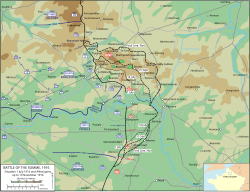| Regina Trench | |||||||
|---|---|---|---|---|---|---|---|
| Part of the Battle of the Somme, First World War | |||||||
 Battle of the Somme 1 July – 18 November 1916 | |||||||
| |||||||
| Belligerents | |||||||
|
| |||||||
| Commanders and leaders | |||||||
|
Douglas Haig Henry Rawlinson |
Fritz von Below Ludwig von Schröder | ||||||
| Strength | |||||||
| 4 Canadian Corps divisions |
Early October: Marinebrigade (3 marine infantry regiments) | ||||||
| Casualties and losses | |||||||
| Canadian: 14,207 |
Marine Infantry Regiment II: 686 | ||||||
The Capture of Regina Trench (Staufen Riegel) was a tactical incident in 1916 during the Battle of the Somme during the First World War. Regina Trench was the Canadian name for a German trench dug along the north-facing slope of a ridge running from north-west of the village of Le Sars, south-westwards to Stuff Redoubt (Staufenfeste), close to the German fortifications at Thiepval. It was the longest such German trench on the Western Front. Attacked several times by the Canadian Corps during the Battle of the Ancre Heights, the 5th Canadian Brigade of the 2nd Canadian Division briefly controlled a section of the trench on 1 October but was repulsed by counter-attacks of the German Marine Brigade (equivalent to an army division), which had been brought from the Belgian coast. On 8 October, attacks by the 1st Canadian Division and the 3rd Canadian Division on Regina Trench also failed.
On 21 October, the 4th Canadian Division attacked the western portion of Regina Trench, as the 18th (Eastern) Division, 25th Division and the 39th Division of II Corps, attacked the part further west (known as Stuff Trench to the British). The Canadians met little opposition and gained the objective, as the II Corps divisions captured Stuff Trench in thirty minutes, giving the Reserve Army (Fifth Army from 30 October) control of Thiepval Ridge. Three counter-attacks were repulsed by the Canadians and by 22 October, more than a thousand Germans had been taken prisoner. The east end of the trench was captured by the 4th Canadian Division during the night of 10/11 November.